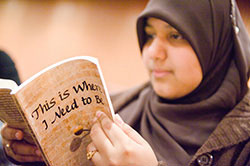TC Study Guide Promotes Understanding of Islam, Muslim Students
About one in 10 students in
The curriculum guide grew out of Cristillo’s study of Muslim youth in
To view Cristillo’s preliminary report of the study, go to www.tc.columbia.edu/i/media/6581_MUSNYCReport.pdf. To purchase the oral history, go to www.lulu.com/content/2456135. The curriculum guide may be downloaded for free at http://www.lulu.com/content/5593634 . To view an online companion to the curriculum guide and book, go to www.thisiswhereineedtobe.com,
The guide is designed to help sixth- through eighth-grade teachers bring to life the themes explored by Muslim students in the oral history: the cultural diversity of the American Muslim communities in the United States; media bias and Islamophobia; negative stereotypes and the role of education in promoting tolerance; the role of American cultural and civic values shaping Muslim identity; and the impact of peer pressure on the lives and attitudes of American Muslim youth. It includes visual aids for teachers to reproduce and include in their lessons. For example, there are images of two masks with heavy, white beards, one with a Santa Claus hat and one with a turban. Students can use the masks as a springboard for a discussion on ethnic stereotypes.
“As educators in the era of globalization, we need to ensure that students are learning about one another from one another—especially in one of the most diverse cities in the world. However, any teacher in a multicultural setting regardless of location could use these curricula and implement it easily into their classroom,” says Teachers College faculty member Erick Gordon, who directs the Student Press Initiative.
The curriculum guide features five lesson plans and companion materials that can be taught over the course of one or two sessions, a semester or a year. Students are prompted to research the lives of notable historical, political and cultural figures that happen to be Muslim; build their own “identity charts”; and analyze media coverage of stories related to Islam. The guide also has tips for students on how to write oral histories. Each lesson addresses the academic standards drawn from the Mid-Continent Research for Education and Learning content guide and can be used in language arts, English, history and social studies classes.
The Student Press Initiative, created and based at Teachers College, is an innovative approach to literacy education that supports middle and high school teachers to advance student learning across the disciplines by engaging them in print and online publication projects. SPI helps teachers transform curriculum so that students read and write their way to becoming published authors, activists, artists and orators—transforming academic assignments into meaningful experiences beyond the classroom. Whether a project culminates in a professionally published book, a public performance with community members, or an online publication with visual and audio text, SPI offers written proof of literacy in action and effective education in the world. For information about SPI, go to http://www.tc.columbia.edu/oscp/detail.asp?id=Curriculum%20Support&Info=Student+Press+Initiative
Published Thursday, Feb. 26, 2009
